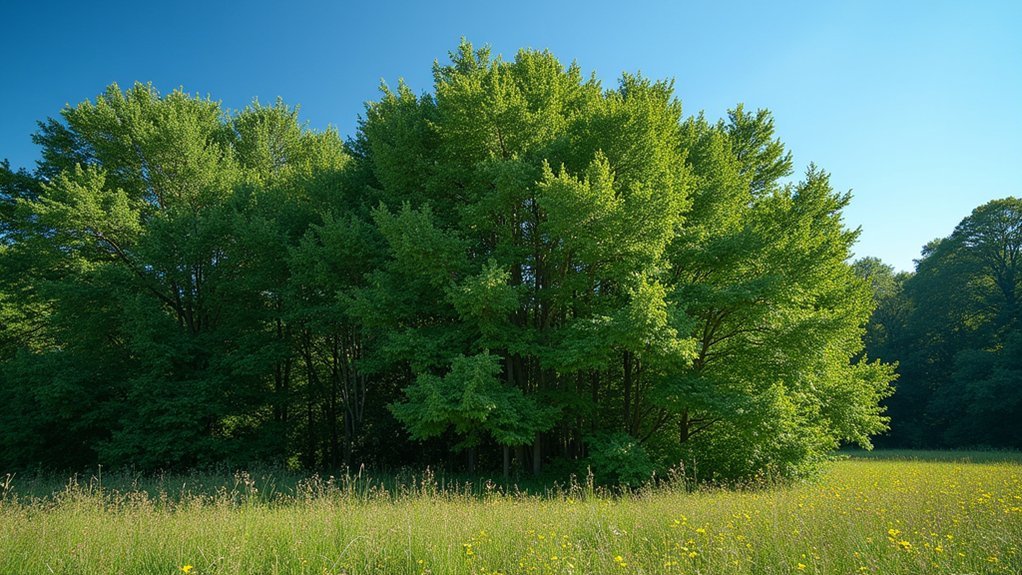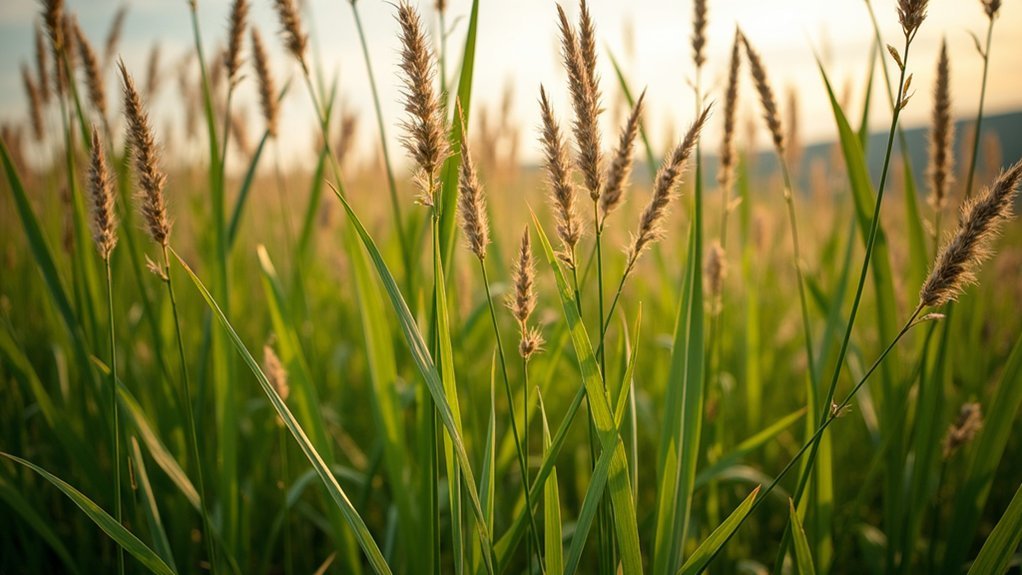Native plants create effective natural sound barriers while supporting local ecosystems. Consider Eastern Red Cedar for year-round noise reduction, American Holly for dense sound absorption, Switchgrass for sound diffusion, Viburnum species for multi-seasonal interest, and Native Evergreen Ferns for ground-level noise control. You’ll get both practical noise reduction and environmental benefits with these hardy, low-maintenance options. Each plant offers unique sound-dampening properties that can transform your outdoor space into a tranquil retreat.
Eastern Red Cedar: The Year-Round Noise Guardian

When seeking a natural solution to unwanted noise, the Eastern Red Cedar (Juniperus virginiana) stands as one of nature’s most effective sound barriers.
Growing up to 40 feet tall with a 20-foot spread, this native evergreen creates a living wall that remarkably reduces noise pollution around your property.
You’ll appreciate its dense foliage that works year-round for consistent sound absorption in all seasons. The tree’s structure naturally catches and diminishes sound waves before they reach your home.
What’s more, you’re getting a low-maintenance addition to your landscape that’s drought-tolerant and adaptable to various soil conditions.
Beyond noise reduction benefits, you’re also providing valuable habitat for local wildlife. Birds and small mammals find shelter and food among its branches, adding biodiversity to your yard.
American Holly: Dense Foliage for Maximum Sound Absorption
Another remarkable native option for noise reduction is the American Holly (Ilex opaca), which offers even greater sound-absorbing capabilities than the Eastern Red Cedar.
You’ll appreciate its dense foliage with thick evergreen leaves that effectively absorb sound waves from nearby traffic or noisy neighbors.
Growing up to 50 feet tall and 40 feet wide, American holly creates substantial sound barriers while adding aesthetic appeal to your landscaping with its glossy, dark green leaves.
Its pyramidal shape and stiff branches not only enhance sound absorption but also serve as a natural windbreak.
What makes American holly particularly valuable is its rapid growth rate, allowing you to establish effective noise reduction solutions more quickly than with other native tree options.
Switchgrass and Native Tall Grasses: The Rustling Sound Diffusers

Although often overlooked in sound barrier planning, native tall grasses like switchgrass (Panicum virgatum) offer exceptional noise reduction qualities through their dense, fibrous structure. You’ll find these grasses can grow up to 6 feet tall, effectively diffusing sound while creating natural white noise as they rustle in the breeze.
| Grass Type | Height | Benefits |
|---|---|---|
| Switchgrass | 4-6 ft | Sound diffusion, wildlife habitat |
| Big Bluestem | 6-8 ft | Superior noise absorption, drought-resistant |
| Indian Grass | 4-7 ft | Year-round sound barrier, erosion control |
Viburnum Species: Versatile Multi-Season Barriers
For homeowners seeking year-round noise reduction with aesthetic appeal, Viburnum species stand out as exceptional choices for sound barriers. Their remarkable dense foliage efficiently absorbs sound waves, considerably reducing noise pollution from busy streets or neighboring properties.
Popular varieties like American Cranberrybush and Blackhaw Viburnum can reach impressive heights of 12 feet, creating effective privacy screens while combating unwanted noise. You’ll enjoy fragrant flowers in spring and colorful berries in fall, providing multi-seasonal interest beyond their practical function.
What makes these shrubs particularly valuable is their adaptability to diverse soil conditions and climates. Their intricate branching structure not only enhances sound absorption but also supports local biodiversity by offering food and shelter for birds and beneficial insects.
Consider incorporating these versatile native plants for a barrier that’s as beautiful as it’s functional.
Native Evergreen Ferns: Ground-Level Sound Control

While Viburnums create impressive upper-story barriers, your noise reduction strategy shouldn’t overlook what’s happening at ground level.
Native evergreen ferns like Christmas fern and Eastern sword fern excel at absorbing sound waves through their dense foliage, creating an effective buffer against unwanted noise.
These resilient plants thrive in shaded areas with moist, well-drained soil where other sound barriers might struggle. By incorporating these ferns into your landscaping, you’ll not only enhance sound control but also support local wildlife habitats.
Their thick, lush growth pattern naturally dampens noise from roads and urban environments.
What makes these ferns particularly valuable is their low-maintenance nature and ability to withstand various environmental conditions, making them a sustainable choice for year-round sound control in your landscape design.
Frequently Asked Questions
What Are the Best Plants for Noise Barrier?
For noise barriers, you’ll find Leyland Cypress, Arborvitae, and Thuja Green Giant most effective. They’re dense evergreens that absorb sound waves year-round. For quicker results, plant them in staggered rows near your noise source.
How Do You Make a Natural Sound Barrier?
You’ll need to plant dense evergreens like Arborvitae in staggered rows near noise sources. Mix with deciduous species for year-round effectiveness. The thicker your planting, the better it’ll block unwanted sound from penetrating through.
Which Plant Reduces Noise Pollution?
Dense evergreen trees like Arborvitae, Cypress, and Holly reduce noise pollution most effectively. You’ll get the best results from Leyland Cypress or Green Giant Arborvitae with their thick, year-round foliage that absorbs sound waves.
How to Block Road Noise in Garden?
To block road noise in your garden, plant dense evergreens like Leyland Cypress close to the road. You’ll get better results by creating staggered rows of mixed vegetation and positioning plants near the noise source.
In Summary
By incorporating these five native sound barrier options into your landscape, you’re not only reducing unwanted noise but also supporting local ecosystems. You’ll enjoy multiple benefits—privacy, wildlife habitat, and reduced maintenance—while addressing your sound concerns naturally. Start with just one species or combine several for layered protection. Remember, patience is key—as these plants mature, they’ll provide increasingly effective noise reduction year after year.





Leave a Reply